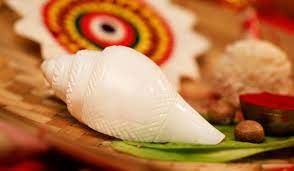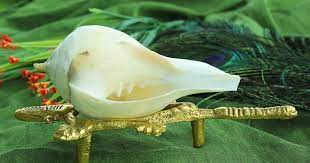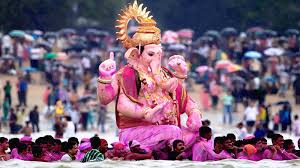I. Introduction
The Significance of the Shankh in Hindu Worship
In the rich tapestry of Hindu spirituality and religious practices, the Shankh in Pooja, or conch shell, occupies a special place of reverence. Its distinct shape and the resounding sound it produces have made it an integral part of various rituals, ceremonies, and daily worship in Hinduism. This article explores the profound significance of the Shankh in Hindu worship and provides insights into how to keep a Shankh in your pooja (prayer) room.
II. Understanding the Shankh
A. Origins and Symbolism
The Shankh in Pooja has deep historical roots in Hindu culture, dating back to ancient scriptures and texts. It is revered not only for its physical attributes but also for its symbolic representation. The Shankh is often associated with Lord Vishnu and is considered a divine emblem of purity and auspiciousness.
- Historical Roots: Delve into the historical origins of the Shankh, tracing its use in ancient rituals and its mention in sacred texts like the Vedas.
- Symbolic Representation: Explore the symbolic significance of the Shankh, including its connection to the conch shell’s spiraling form and its representation of the cosmic sound, Om.
B. Types of Shankhs
The Shankh comes in various types, each with its unique characteristics and significance in Hindu worship.
- Dakshinavarti Shankh: Discuss the Dakshinavarti Shankh, known for its clockwise spiral, and its association with wealth and prosperity.
- Valampuri Shankh: Explain the Valampuri Shankh, characterized by its counterclockwise spiral, and its sacredness in Hindu rituals.
- Gomukhi Shankh: Explore the Gomukhi Shankh, named for its resemblance to a cow’s mouth, and its use in religious ceremonies.
- Matsya Shankh: Introduce the Matsya Shankh, which is believed to represent the fish incarnation of Lord Vishnu, and its spiritual significance.


III. Selecting a Shankh for Your Pooja Room
Before incorporating a Shankh into your pooja room, it’s essential to choose the right one. This section guides readers on the factors to consider when selecting a Shankh.
A. Authenticity and Source
Highlight the importance of sourcing a Shankh from a reputable and authentic supplier, emphasizing the need to verify its origin and authenticity.
B. Size and Shape
Discuss how the size and shape of a Shankh can affect its presence in a pooja room and its ease of use in rituals.
C. Condition and Sound
Explain the significance of a Shankh’s condition and its ability to produce a clear and resonant sound, which is crucial in Hindu worship.
IV. Preparing the Shankh for Worship
Once you’ve acquired a Shankh, there are essential steps to prepare it for worship.
A. Cleaning and Purification
Guide readers through the process of cleaning and purifying the Shankh, ensuring it is free from impurities.
B. Consecration Rituals
Explain the consecration rituals, or Pranapratishtha, which infuse divine energy into the Shankh, making it spiritually potent.
C. Appropriate Placement
Discuss the ideal placement of the Shankh in the pooja room, considering factors like direction and alignment.
V. The Role of the Shankh in Pooja
Detail the multifaceted role of the Shankh in Hindu worship.
A. Aesthetic and Spiritual Significance
Highlight how the Shankh’s physical beauty and spiritual symbolism enhance the atmosphere of the pooja room.
B. Invocation and Prayers
Explain how the Shankh is used to invoke deities and offer prayers during rituals, including its role in Aarti.
C. Sound and Vibration
Explore the significance of the sound produced by the Shankh, which is believed to purify the environment and ward off negative energies.
VI. Maintaining the Shankh
To ensure the longevity and efficacy of the Shankh in Pooja, proper maintenance is essential.
A. Cleaning and Preservation
Provide guidance on regular cleaning and preservation techniques to prevent damage and discoloration.
B. Dealing with Damage or Discoloration
Offer solutions for addressing common issues like chipping or discoloration, emphasizing the importance of care.
VII. Significance of Sound in Hindu Worship
Delve into the broader context of sound in Hindu rituals and the spiritual significance of the Shankh’s resonance.
A. Nada Yoga and the Power of Sound
Explain the concept of Nada Yoga, the yoga of sound, and how it relates to the use of the Shankh.
B. The Shankh’s Role in Sound Invocation
Discuss how the Shankh’s sound invocation can elevate the spiritual experience during worship.
VIII. Incorporating the Shankh in Daily Worship
Provide practical guidance on including the Shankh in daily worship routines.
A. Morning and Evening Rituals
Explain how the Shankh can be integrated into morning and evening pooja rituals for blessings and protection.
B. Special Occasions and Festivals
Highlight specific festivals and occasions where the Shankh plays a pivotal role and guide readers on its use during these times.
IX. Respect and Reverence
Promote cultural and religious sensitivity when handling the Shankh.
A. Cultural and Religious Sensitivity
Encourage readers to approach the Shankh with respect and awareness of its cultural and religious significance.
B. Avoiding Common Misconceptions
Address common misconceptions about the Shankh, emphasizing its sacredness.
X. Conclusion
Summarize the key takeaways from the article, reiterating the significance of the Shankh in Hindu worship and encouraging readers to embrace this sacred tradition in their pooja rooms.























Leave a Reply